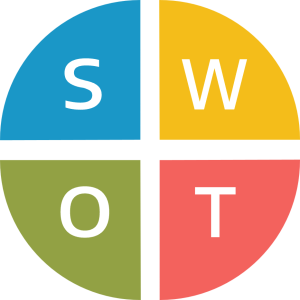Few strategy tools have been criticised as much as the SWOT analysis. It’s been called outdated, simplistic, even ‘stupid’. And yet, it remains one of the most widely used tools in boardrooms around the world. Why? Because when it’s done properly, SWOT forces companies to ask the hard question: can we really succeed with this strategy? That’s why I keep it in my toolbox.

Why CEOs dismiss SWOT too quickly
Many popular strategy frameworks ignore the capabilities of the company making the strategy. Porter’s five forces analysis is all about the market (customers, suppliers, competitors) regardless of which company wants to compete there. The BCG growth-share matrix looks at a company’s current market share, but not at its ability to retain or grow that share. A business model canvas describes a company’s (desired) business model but doesn’t say if the company is any good at applying it.
I have written before about large companies having the same strategy. Many companies sound as if a strategy is something bland that you pick out of a menu of generic options. “We will elevate our brand by running our stores better” or “We will innovate using data-based insights” or “We are increasing value and choices for customers” (Yes, those are actual quotes.) Does any other company want to do these? Going once, going twice…
SWOT helps you to see capabilities clearly
In a SWOT analysis, you have to assess what this company is good or bad at, and will the market help or hinder it, in the context of its desired strategy. SWOT brings together the internal and external factors that can support or derail the strategy. Those are not independent of each other, even if they are presented as such.
Let’s take “We will innovate using data-based insights” as an example. Is this company good at data? Good at insights? Good at innovation? Good enough for it to be their competitive advantage that will help them win in the market?
SWOT isn’t the only framework to look at capabilities. There are frameworks such as Barney’s VRIO, or Leinward and Mainardi’s Essential Advantage. Roger Martin’s fourth strategic question is ‘What capabilities must we have?’ Note the must we rather than the do we in this question.
How I use SWOT in creating successful strategies
I like to start with SWOT because it’s much simpler and, frankly, blunter – what does this company suck at? If we’re not clear-eyed about that, then we can write a strategy that says we will do all these new things and discover six months later that we’re not able to do them after all even if we earnestly aspire to.
SWOT is easy to understand and has a low entry barrier. I suspect that that is why it’s enduringly popular. One aspect that always needs explanation is that strengths and weaknesses are internal and opportunities and threats are external. People often get those wrong, so I reallocate those to the right category when capturing the content.
It’s not useful to make a SWOT with only one person. I ask all members of a company’s management team for their SWOT, and often find that each one has a different opinion. I gain three insights from this exercise: how do they see themselves, what topics do they think about, and to what level of detail do they go?
I push for more specificity on each topic. A generic trend like “AI” isn’t an opportunity or a threat: Who will do what with which AI and how will that affect your business? If I feel the inputs are too self-congratulatory then I will play devil’s advocate and ask them to back them up with facts.
The real value: Turning SWOT into action
Has SWOT added value in making strategy? Yes it has. For one of my clients, summarising their situation in a SWOT analysis revealed a weakness on low product yield that added a new initiative to their strategic action plan.
For another client, we had four potential future scenarios for product innovation, and the operations team members assessed each scenario using SWOT. The surprising outcome was that the higher-risk new product scenario was seen as having more opportunities, and was preferred to the lower-risk existing product scenario despite needing to build more new capabilities.
Filling in a SWOT table isn’t going to give you a strategy, any more than filling in a business model canvas is going to give you a successful business model. But it does have its uses when creating an actionable strategy, and I will happily continue to endorse and use it.
© Veridia Consulting, 2024-25


